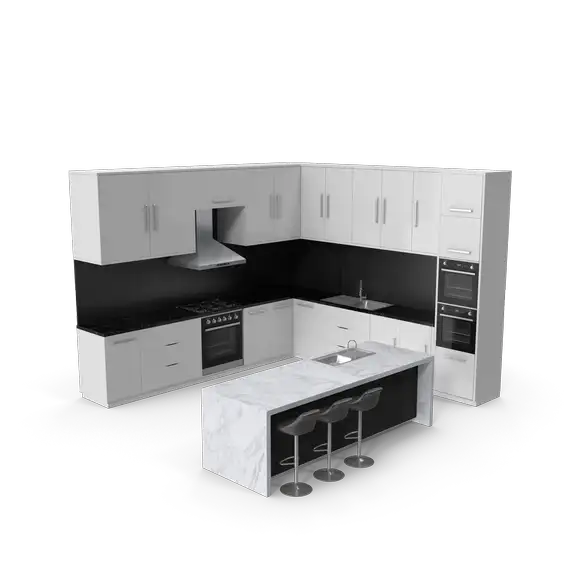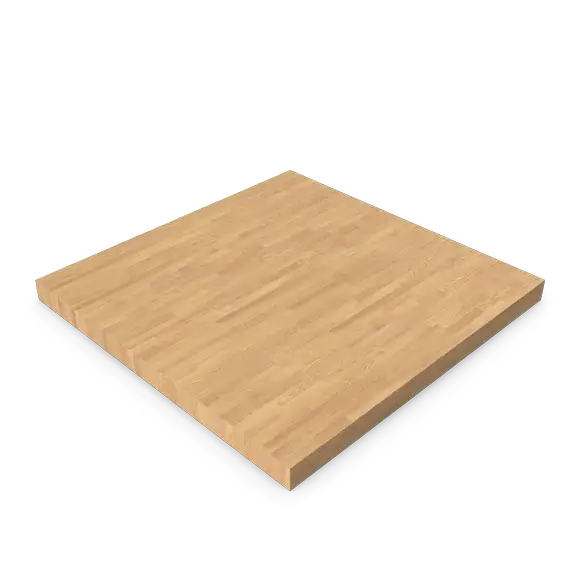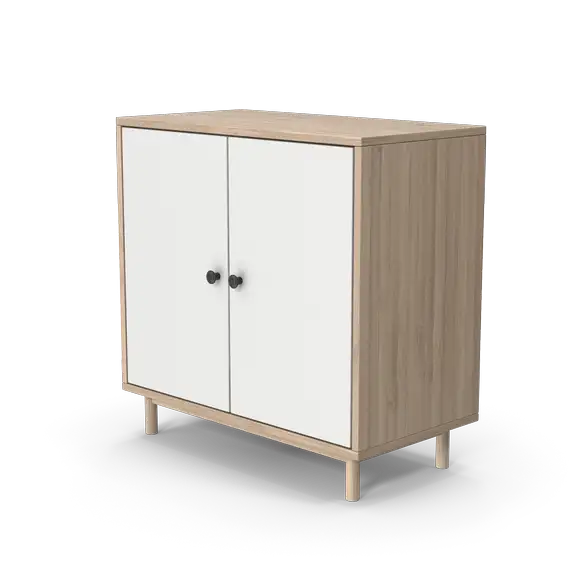What is a High-Gloss Finish?
A high-gloss finish refers to a paint or varnish that leaves a very shiny and reflective surface once it dries. Known for its ability to reflect light, this finish type is highly favored for its aesthetic appeal and practical benefits, making it a popular choice in various interior design projects.
Characteristics of High-Gloss Finishes
High-gloss finishes are distinct for their brilliant, glass-like sheen. They are the most durable of all paint finishes, capable of withstanding wear and tear while retaining their lustrous appearance. The high reflectivity enhances the vibrancy of the color underneath, adding depth and richness to the applied surfaces.
Benefits of High-Gloss Finish
- Durability: High-gloss paints and varnishes create a hard, durable surface that is resistant to moisture and staining, making it ideal for high-traffic areas and surfaces that undergo frequent cleaning.
- Ease of Cleaning: The smooth and non-porous nature of high-gloss finishes makes them exceptionally easy to clean. Dirt and grime can be wiped off easily without damaging the surface.
- Aesthetic Appeal: High-gloss finishes can transform a space by reflecting light and adding a vibrant, polished look to furniture, cabinetry, and trim.
- Protective Qualities: Besides enhancing aesthetics, these finishes provide a protective barrier that shields surfaces from environmental factors and daily wear and tear.
Common Applications of High-Gloss Finish
- Kitchens and Bathrooms: Due to their resistance to moisture and ease of cleaning, high-gloss finishes are commonly used on cabinets, backsplashes, and bathroom fixtures.
- Furniture: Pieces like dining tables, chairs, and decorative shelving benefit from high-gloss finishes for both their visual appeal and protective properties.
- Trim and Moldings: Door frames, moldings, and baseboards are often coated with a high-gloss finish to highlight architectural details and offer durability.
Installation and Maintenance Tips
- Proper Application: For the best results, surfaces should be thoroughly prepared—sanded, cleaned, and primed—before applying high-gloss paint. It’s also important to use high-quality brushes or rollers to avoid streaks and achieve a smooth finish.
- Maintenance: To maintain the lustrous look, regularly clean the surfaces with a soft cloth and mild detergent. Avoid abrasive cleaners that can scratch or dull the glossy surface.
Challenges and Considerations
- Surface Preparation: High-gloss finishes highlight surface imperfections, so proper preparation is crucial. Any bumps or cracks should be filled and sanded smooth before application.
- Application Technique: Applying high-gloss finishes requires precision and technique to avoid drips and brush marks, which are more visible due to the reflective nature of the finish.
Cost Analysis of High-Gloss Finish
Investing in a high-gloss finish can vary significantly in cost depending on several factors:
- Type of Paint/Varnish: High-quality high-gloss paints are typically more expensive than their matte or eggshell counterparts due to the enhanced chemical composition that provides durability and shine.
- Surface Area and Labor: The cost also depends on the total area to be covered and the complexity of the job. Labor costs can be higher, as applying a high-gloss finish requires more preparation and skill to achieve a flawless finish.
Comparative Analysis with Other Finishes
High-gloss finishes stand out when compared to other finishes like satin, matte, or eggshell, primarily due to their reflectivity and durability. Here’s how they stack up:
- Durability and Maintenance: High-gloss finishes are superior in terms of resistance to moisture and ease of cleaning, making them ideal for kitchens and bathrooms, unlike matte finishes which absorb more moisture and dirt.
- Aesthetic Impact: While satin and eggshell finishes provide a subtler, softer look, high-gloss finishes are preferred for a dramatic, elegant appearance that enhances the colors and makes the space feel larger and brighter.
Impact on Property Valuation
Properties with high-gloss finishes tend to have higher market values, particularly in luxury markets where visual appeal and modern aesthetics are highly prized. A well-executed high-gloss finish in a home can highlight architectural details and give the space a more curated, designed feel, which can attract higher offers from potential buyers.
Historical Context
The use of high-gloss finishes has evolved significantly over the decades. Originally seen in the lavish homes of the elite, these finishes became more accessible with advances in paint technology in the 20th century. Today, high-gloss finishes are used by a broad demographic to add a touch of luxury and cleanliness to homes and commercial spaces.
Creative Uses and Innovative Trends
High-gloss finishes are not just limited to walls or woodwork; innovative uses include:
- Ceilings and Floors: Applying high-gloss finishes to ceilings or floors can create a bold statement and transform the ambiance of a room.
- Outdoor Applications: Advances in the formulation of high-gloss finishes have led to more durable outdoor applications, allowing for glossy exteriors that can withstand the elements.
DIY Tips for Applying High-Gloss Finishes
For those considering a DIY approach:
- Tool Selection: Use high-density foam rollers or sprayers instead of traditional brushes to avoid brush marks and achieve a smooth finish.
- Tackling Imperfections: Prior to application, invest time in meticulously sanding and priming the surfaces to get rid of any imperfections, as high-gloss paint will make these more noticeable.
Advanced Techniques for Applying High-Gloss Finishes
Achieving a flawless high-gloss finish requires precision and attention to detail. Here are some advanced techniques that can help ensure optimal results:
- Wet Sanding: Between coats, wet sanding with fine-grit sandpaper can help achieve an ultra-smooth surface, which is essential for a mirror-like finish.
- Layering: Applying several thin layers of high-gloss paint rather than a few thick ones can prevent drips and streaks, allowing each layer to dry completely before applying the next.
Environmental Considerations and Best Practices
While high-gloss finishes offer many benefits, it’s important to consider their environmental impact:
- VOC Levels: High-gloss paints traditionally contained high levels of volatile organic compounds (VOCs). Opting for newer, low-VOC or VOC-free high-gloss paints can help minimize environmental impact and indoor air pollution.
- Sustainable Practices: Utilizing high-gloss finishes made from sustainable or recycled materials can also contribute to eco-friendly building practices, aligning with global trends towards more environmentally conscious construction.
Psychological Impact of High-Gloss Finishes
The choice of finish in an environment can significantly affect how the space is perceived and experienced:
- Space Enhancement: High-gloss finishes are excellent for making small rooms appear larger and brighter as they reflect light deeply into the room.
- Mood Elevation: The luminous quality of high-gloss finishes can elevate the mood by creating a vibrant and energetic environment, making them popular choices for spaces designed to stimulate interaction and creativity.
Economic Benefits of High-Gloss Finishes
Investing in high-gloss finishes can also offer long-term economic benefits:
- Increased Durability: Because they are easier to clean and maintain, high-gloss finishes reduce the need for frequent repainting or touch-ups, providing cost savings over time.
- Enhanced Property Appeal: Properties featuring high-quality finishes like high-gloss are often more appealing to potential buyers or renters, potentially increasing property income and investment returns.
Future Trends in High-Gloss Finishes
As technology advances, the future of high-gloss finishes looks promising with innovations such as:
- UV-Cured Finishes: These involve applying a finish that is then cured with ultraviolet light, creating an extremely durable high-gloss surface that is resistant to scratches, stains, and solar degradation.
- Eco-Friendly Formulations: The development of high-gloss finishes that require less energy to produce and contain biodegradable components is likely to accelerate, catering to the growing demand for sustainable building materials.
Comprehensive Guide to High-Gloss Finishes Across Applications
High-Gloss Finish Varieties and Specific Applications
High Gloss Black Finish: Ideal for achieving a striking, deep black look on metals and woods. This finish is commonly used in automotive detailing and high-end furniture to create a sleek, contemporary aesthetic.
Best High Gloss Finish for Wood: Products like polyurethane and lacquer are considered best for achieving a high gloss on wood surfaces, enhancing durability and providing a rich, lustrous sheen that is perfect for fine furniture and decorative woodwork.
High Gloss Bar Top and Table Top Finish: Epoxy resin is widely favored for bar tops and tables because of its ability to create a thick, glossy, and impervious layer that is both stunning and highly resistant to water, stains, and impacts.
High Gloss Concrete Finish: Sealing concrete with a high gloss finish not only protects it but also enhances the color and texture of the concrete, making it a popular choice for floors in homes and commercial spaces.
High Gloss Powder Coat Finish: Known for its robustness, the high gloss powder coat offers a superior level of finish for metal products, providing excellent hardness and resistance to chipping or fading.
Corian High Gloss Finish: Achieving a high gloss finish on Corian solid surfaces is often done to accentuate color depth and achieve a mirror-like surface that’s both modern and easy to maintain.
High Gloss Floor Finish: Products like Bona high gloss floor finish are favored for their durability and the brilliant shine they add to wooden and laminate floors, making them particularly useful in high-traffic areas.
Dulling Down a High Gloss Finish Floor: Sometimes the sheen of a high gloss floor needs to be dulled for safety or aesthetic reasons, which can be achieved using specific matte or satin finish products designed to overlay a glossy surface without compromising the underlying protection.
High Gloss Finish Furniture and kitchen cabinets: High gloss lacquer finishes are especially popular for kitchen cabinets and modern furniture pieces, providing a sleek, reflective look that enhances color and adds a touch of luxury.
High Gloss Automotive Finish: Automotive paints with a high gloss finish are used to provide vehicles with a vibrant, clean look that also serves as a protective barrier against environmental elements.
Veneer and High Gloss Polyester Finish: These finishes are applied to veneers on furniture and panels, offering a cost-effective way to achieve a high-end look without using solid wood or expensive materials.
High Gloss Finish on Acrylic Painting and Crafts: A high gloss varnish can transform the appearance of acrylic paintings and craft projects, enhancing colors and providing a protective coat that resists dust and fading.
High Gloss Oil and Lacquer Wood Finish: These traditional finishes are favored for their ability to penetrate deep into the wood, providing both nourishment and a stunning glossy surface that highlights the natural grain.
High Gloss Sealer Miracle and Reviews: Products like Miracle high gloss finish sealer are praised in reviews for their ability to lock in the aesthetics while providing a durable shield against moisture and stains.
Getting a High Gloss Finish on Epoxy and Guitar: Techniques for achieving a high gloss finish on epoxy surfaces and musical instruments like guitars involve careful application and polishing to ensure a flawless end result.
Frequently Asked Questions (FAQs) about High-Gloss Finish
These FAQs aim to cover the most common questions about high-gloss finishes, providing valuable information that helps homeowners and DIY enthusiasts achieve the best results with their projects.








